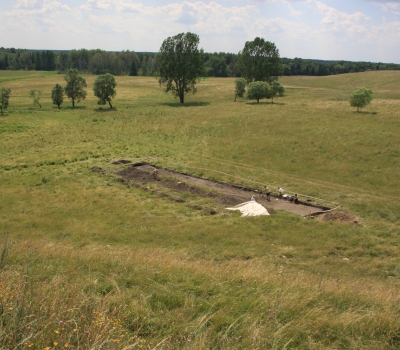
In the summer of 2014 the State Archaeological Museum in Warsaw (PMA) had the settlement complex at Skomack (Ostrowie) excavated by Stowarzyszenie Starożytników – a public benefit association of antiquarians. The dig was run by Michał Hrynczyszyn (SS) and dr Marcin Engel (PMA), with some consultation from the Department of Balt Archaeology of the museum in Warsaw. The aim of the excavation project – the first in many years – was to investigate the two main sites of the complex and confirm data from non-destructive studies.
Analysis of data from non-destructive studies was used in planning the location of the excavation trenches: one on the western slope of the Grodzisko (“Earthwork”) Hill, the second on the site of an open settlement lying at the southern foot of the elevation. Jointly, more than 300 m² of the two archaeological sites were investigated
The archaeological excavation consisted of stripping the humus by arbitrary layer and exploration of the culture deposit and the archaeological features using the stratigraphic method. Metal detectors were used, the finds recorded in 3D. Parallel to the descriptive documentation, drawn and orthophoto documentation was also assembled. At the end of the fieldwork the site was restored to the status quo from before the excavation.
A few dozen archaeological features and culture layers were identified and recorded during the excavation; a large assemblage of pottery fragments was recovered as well as several complete vessels and a few dozen non-ceramic artefacts. The excavated material corresponds to five occupation horizons datable to the Early Iron Age, Roman Period, Migration Period, early medieval period and the modern age.


